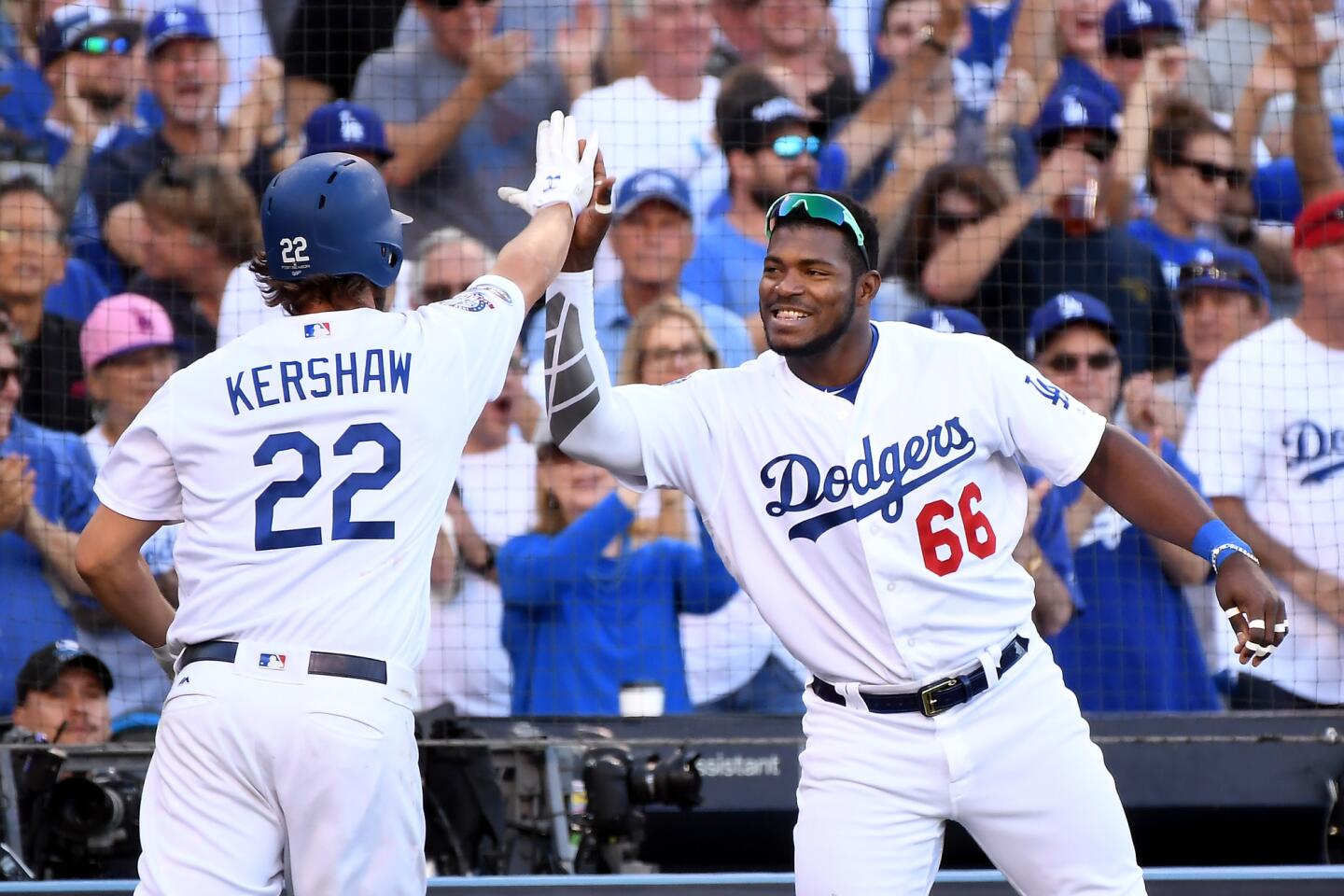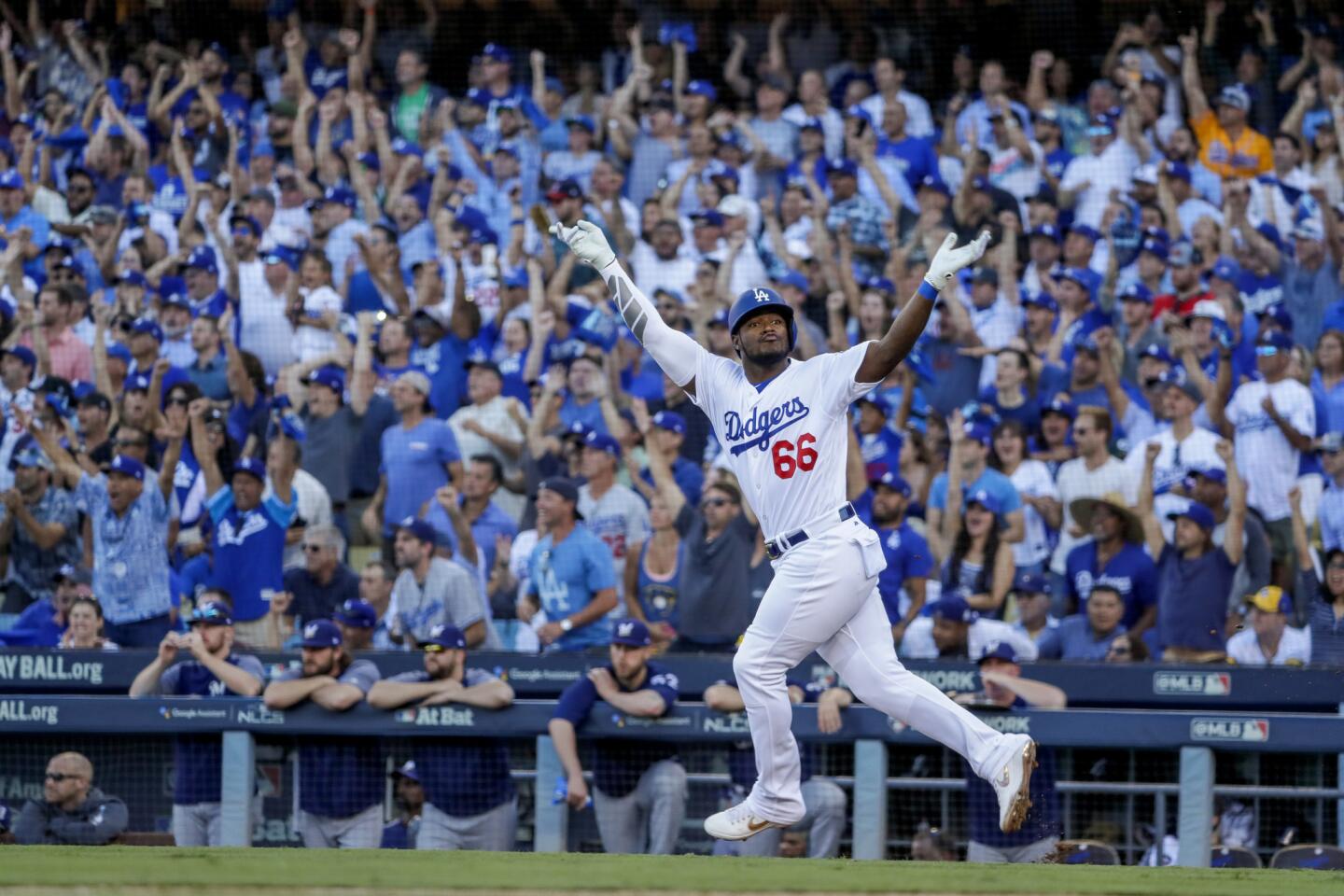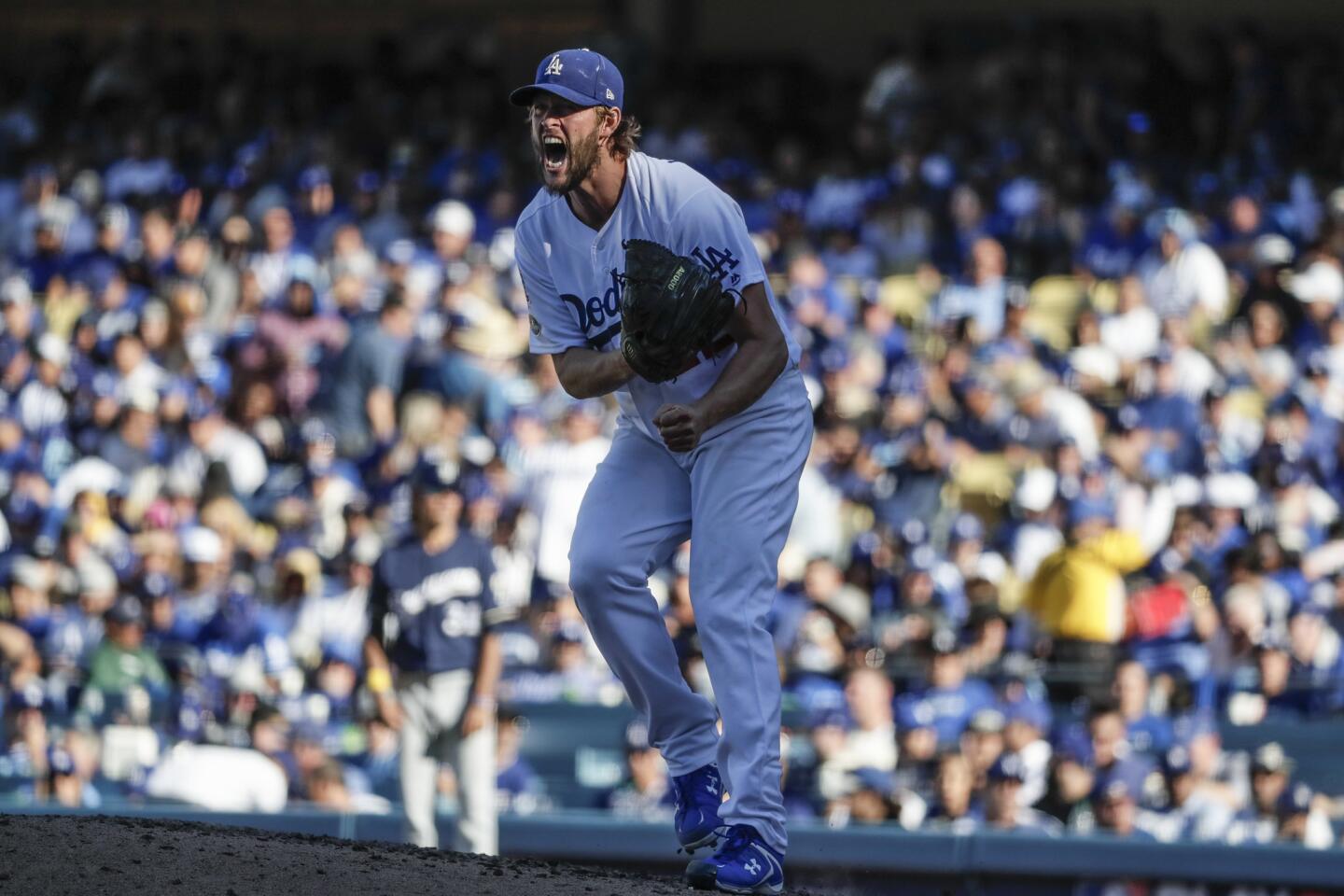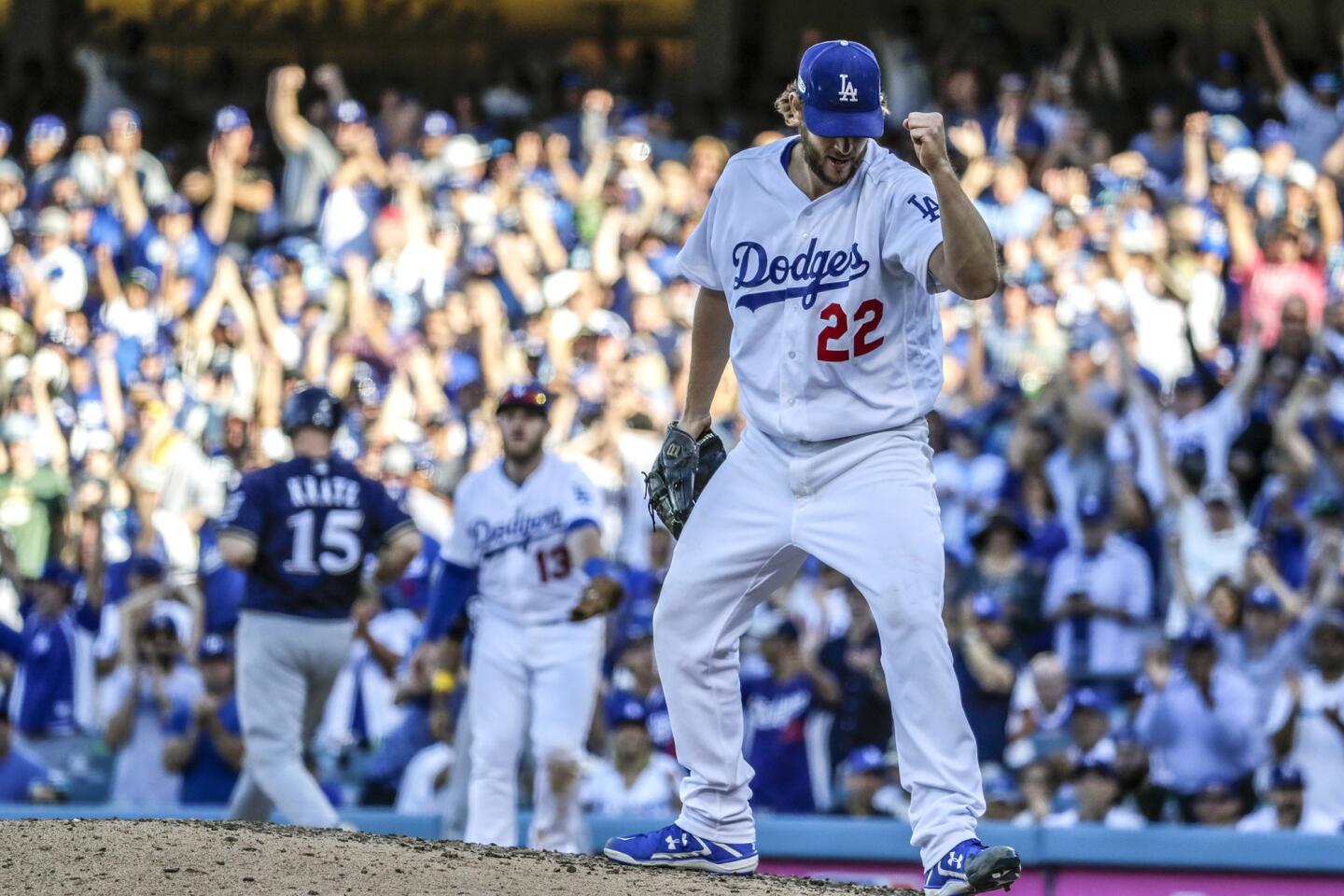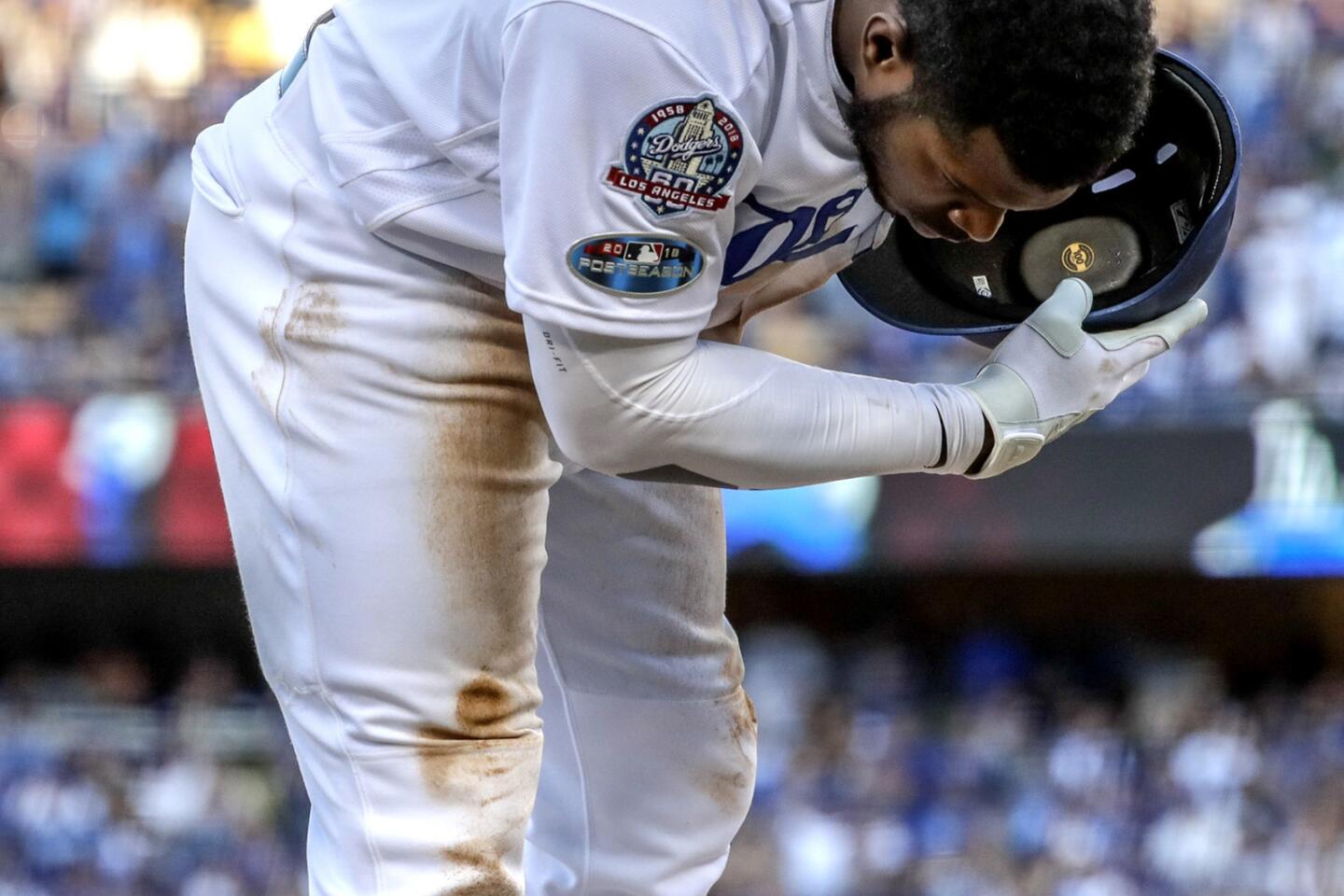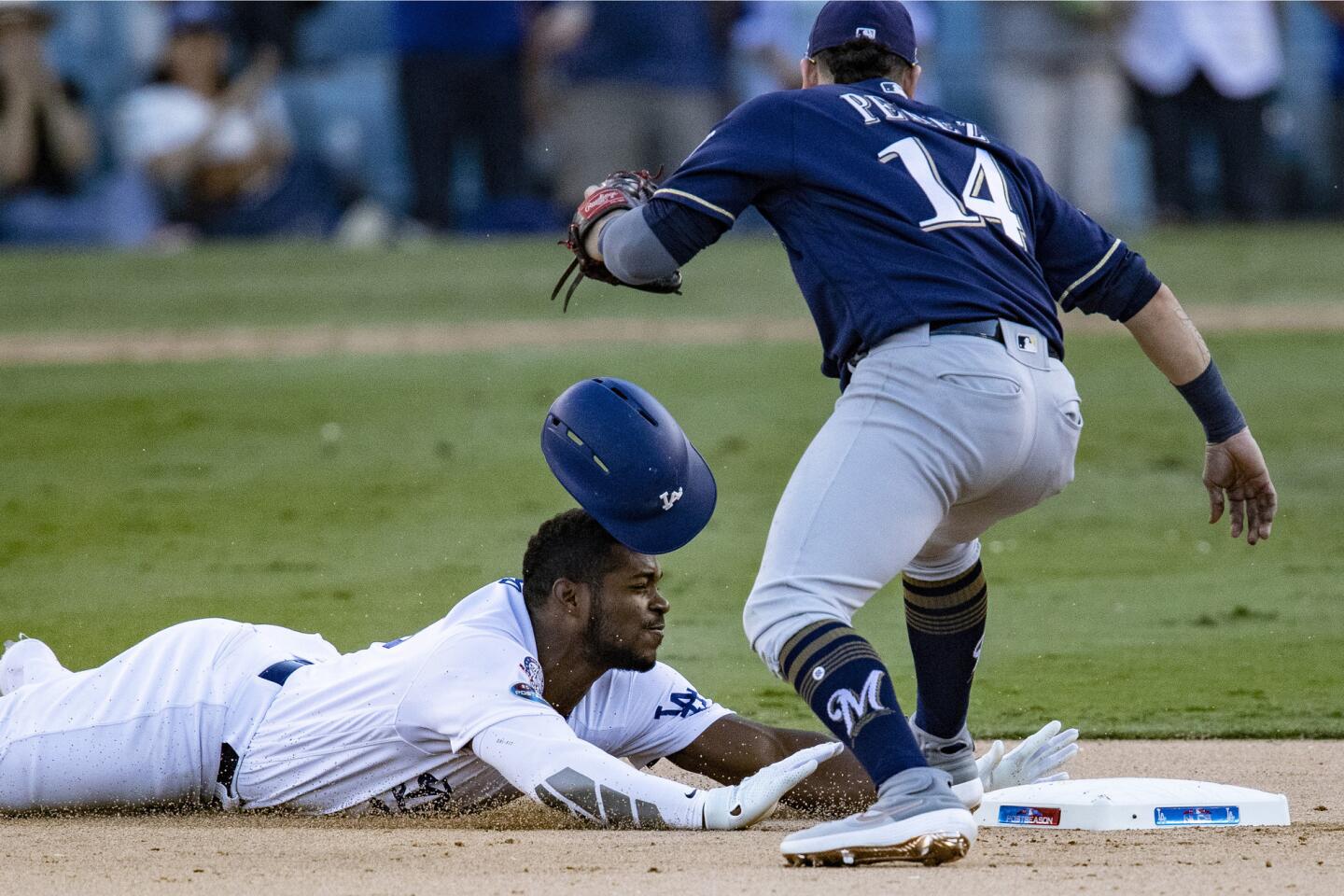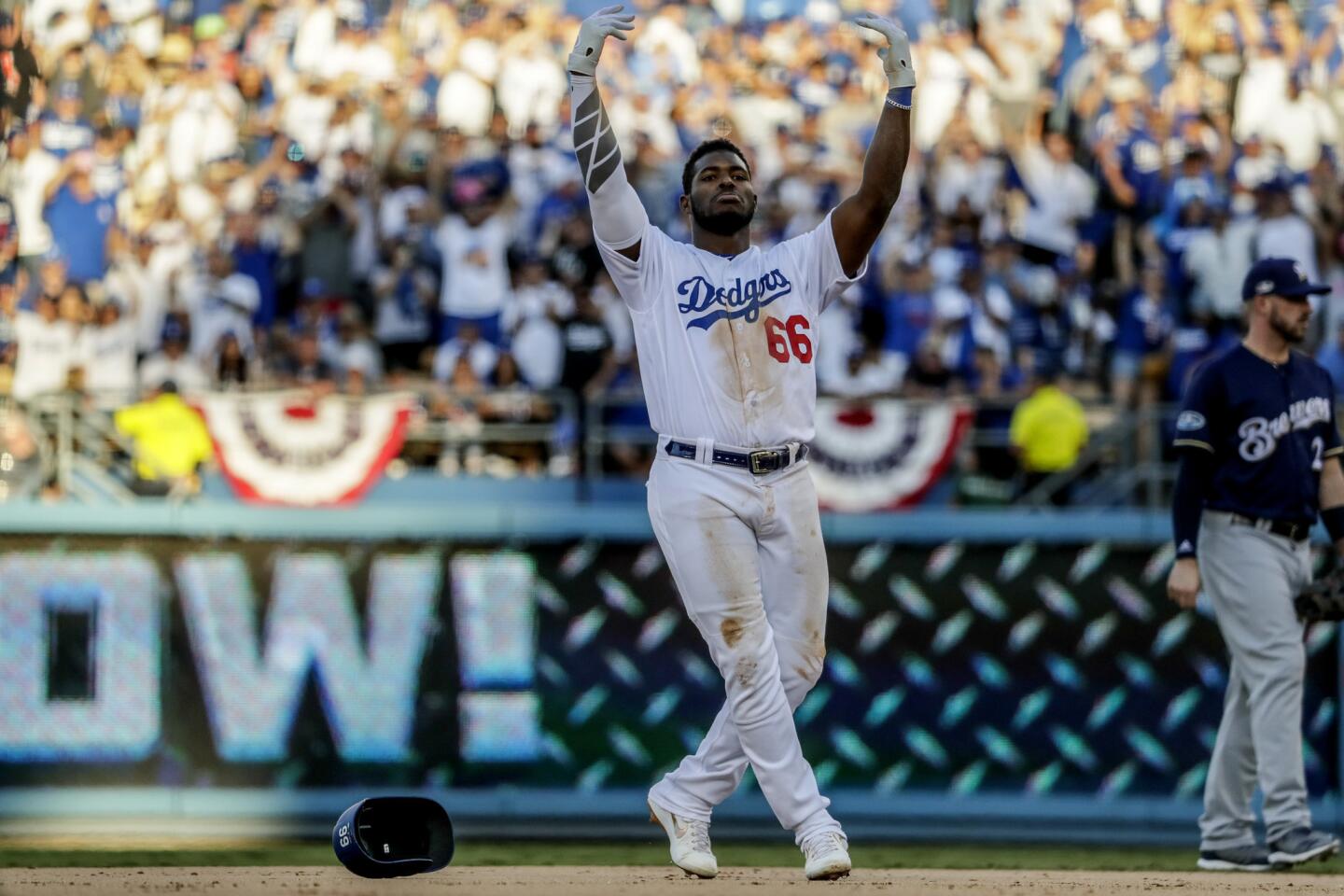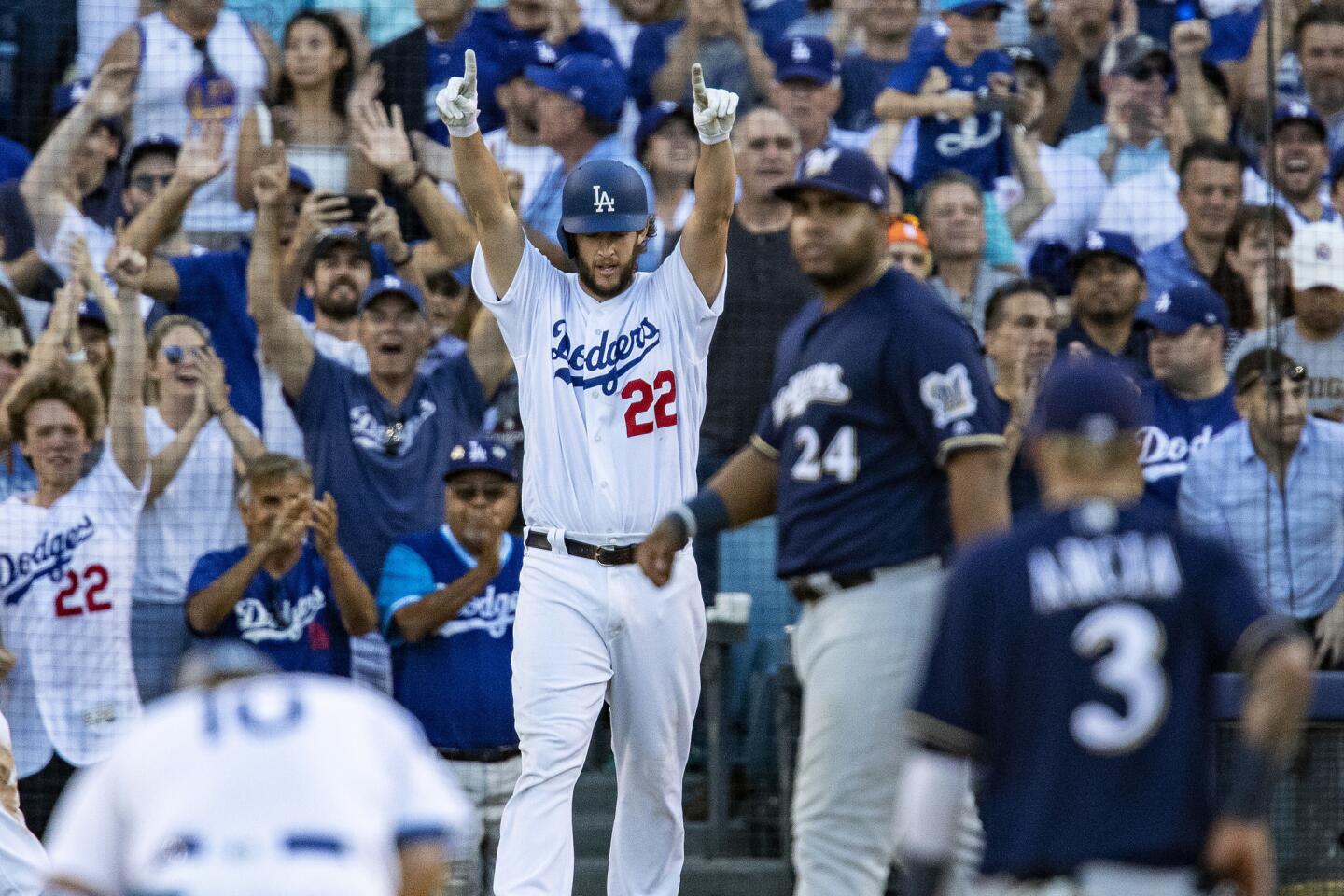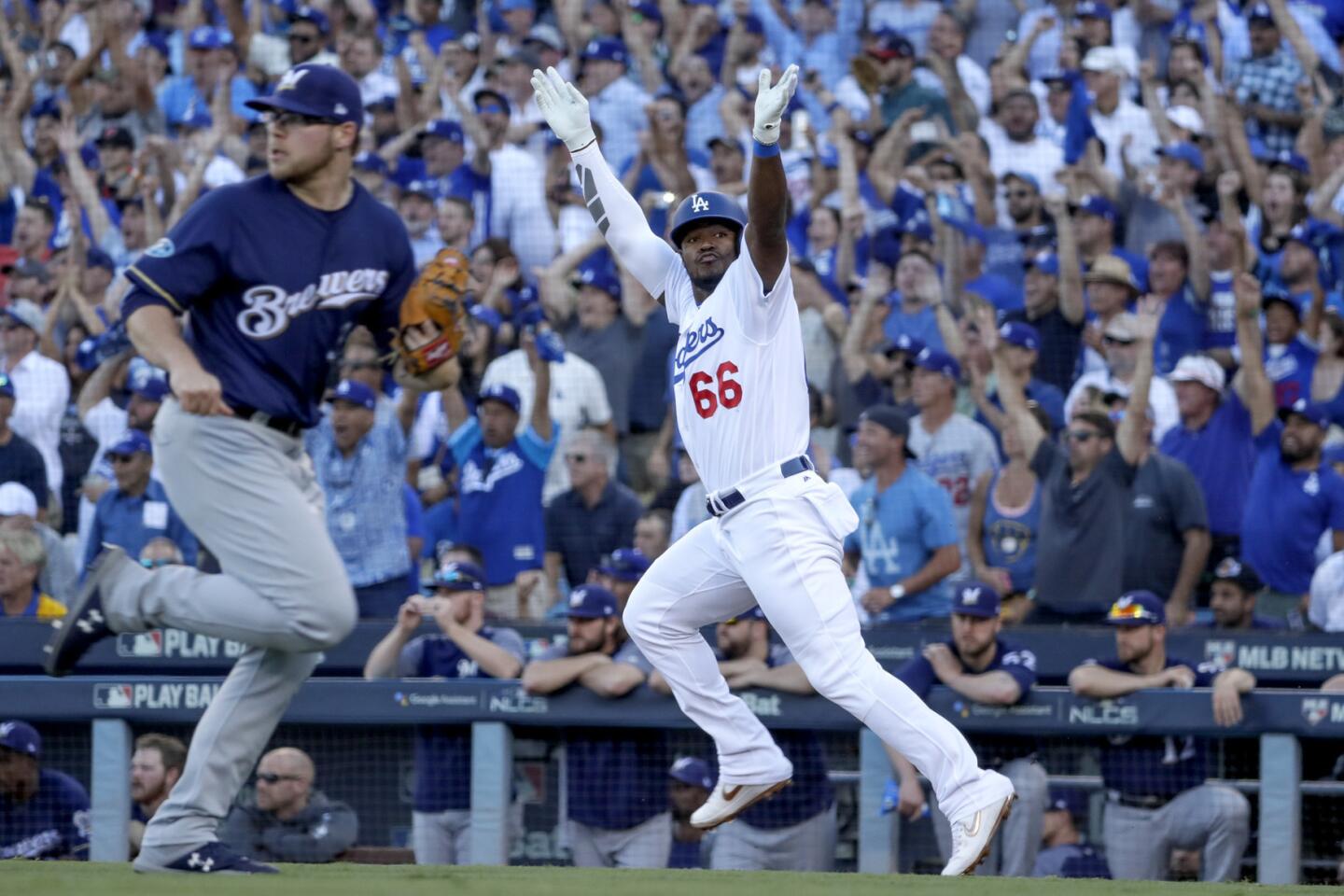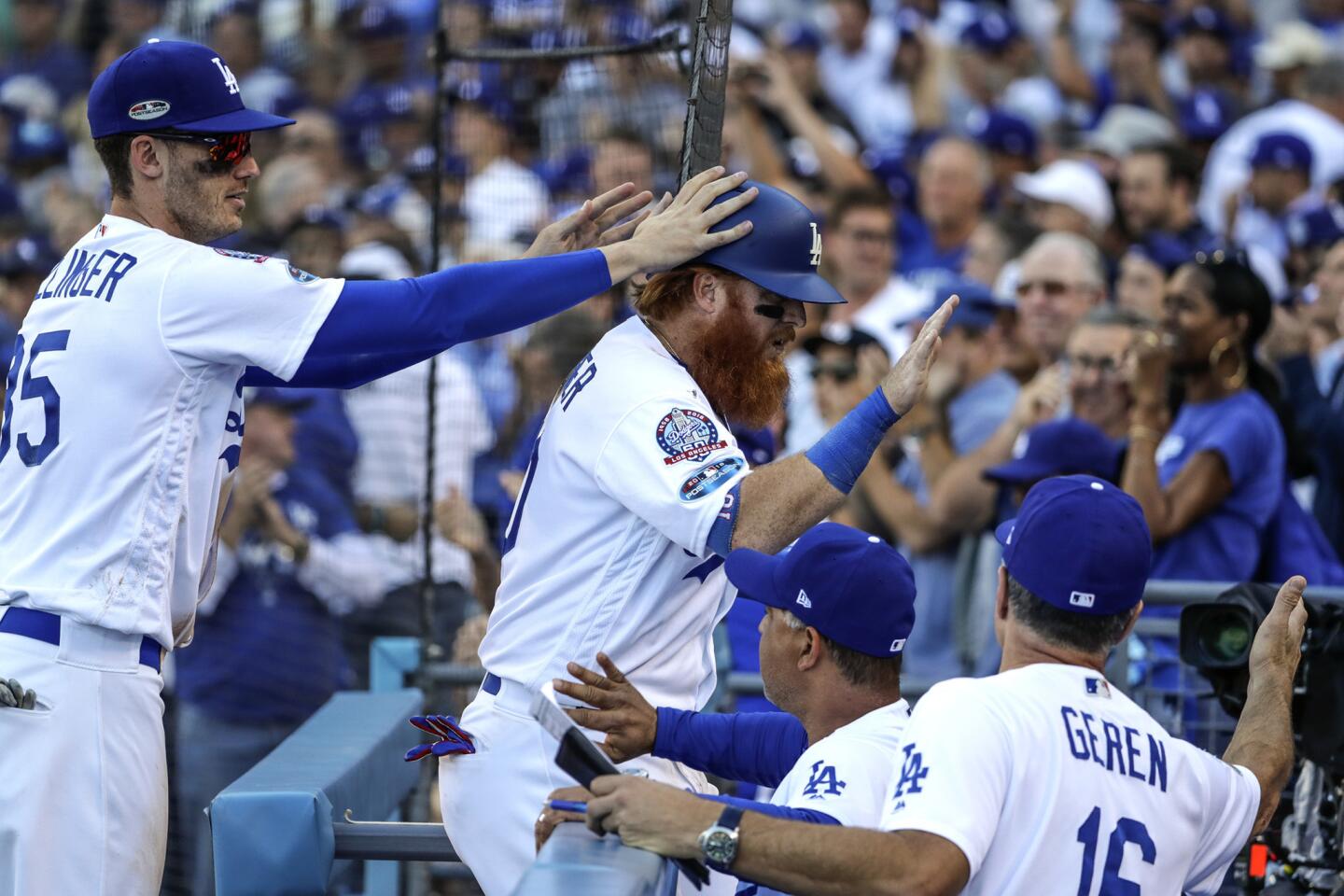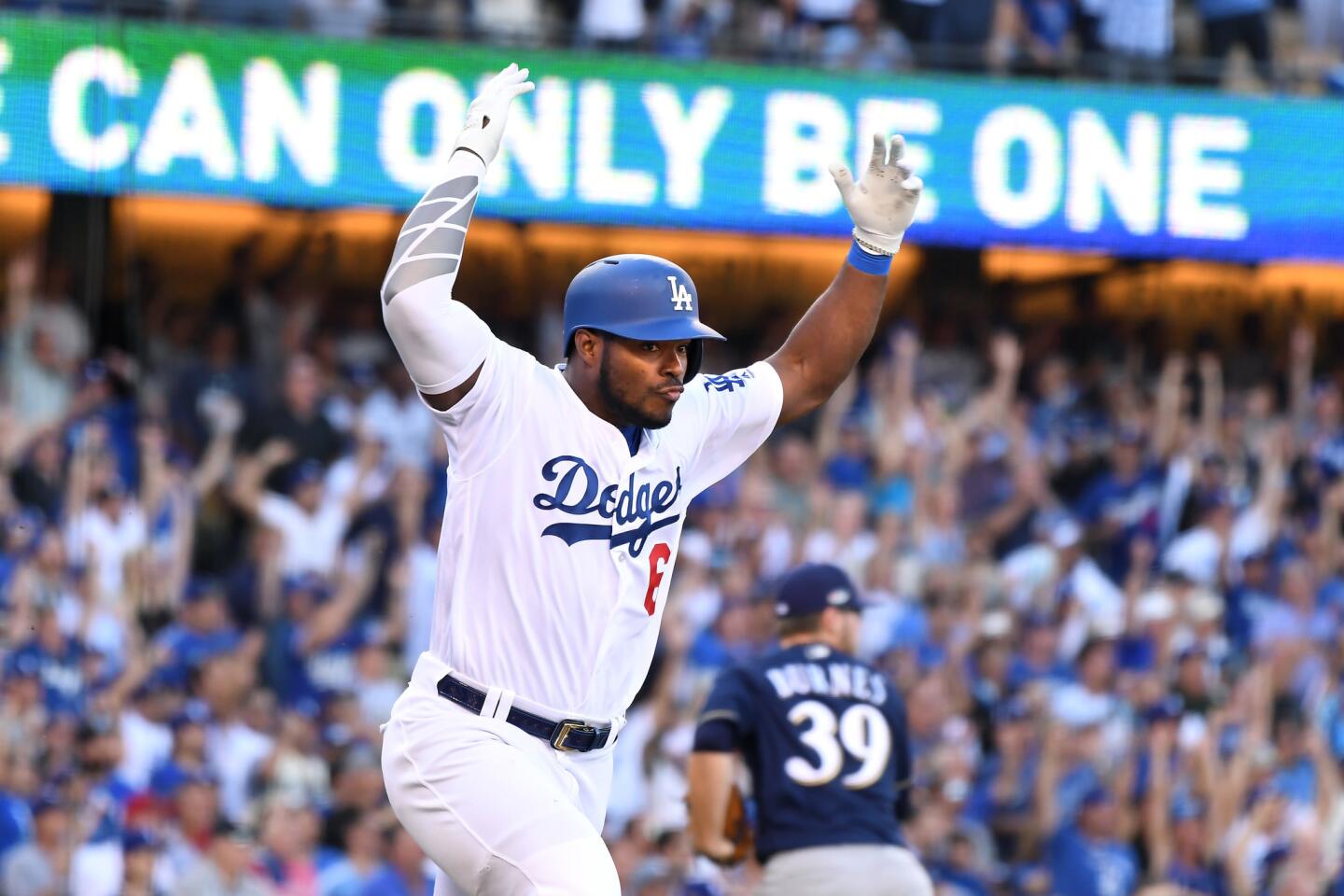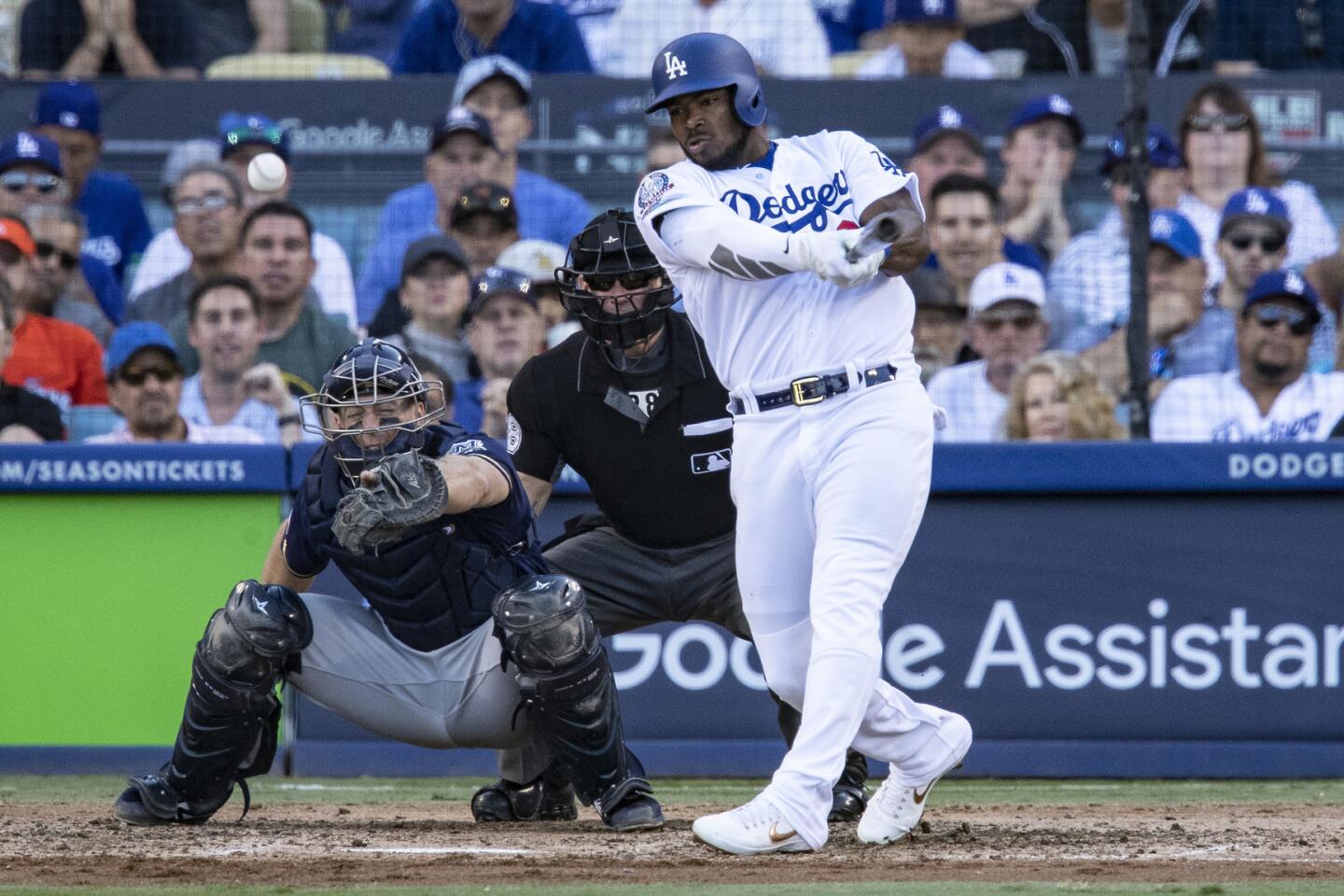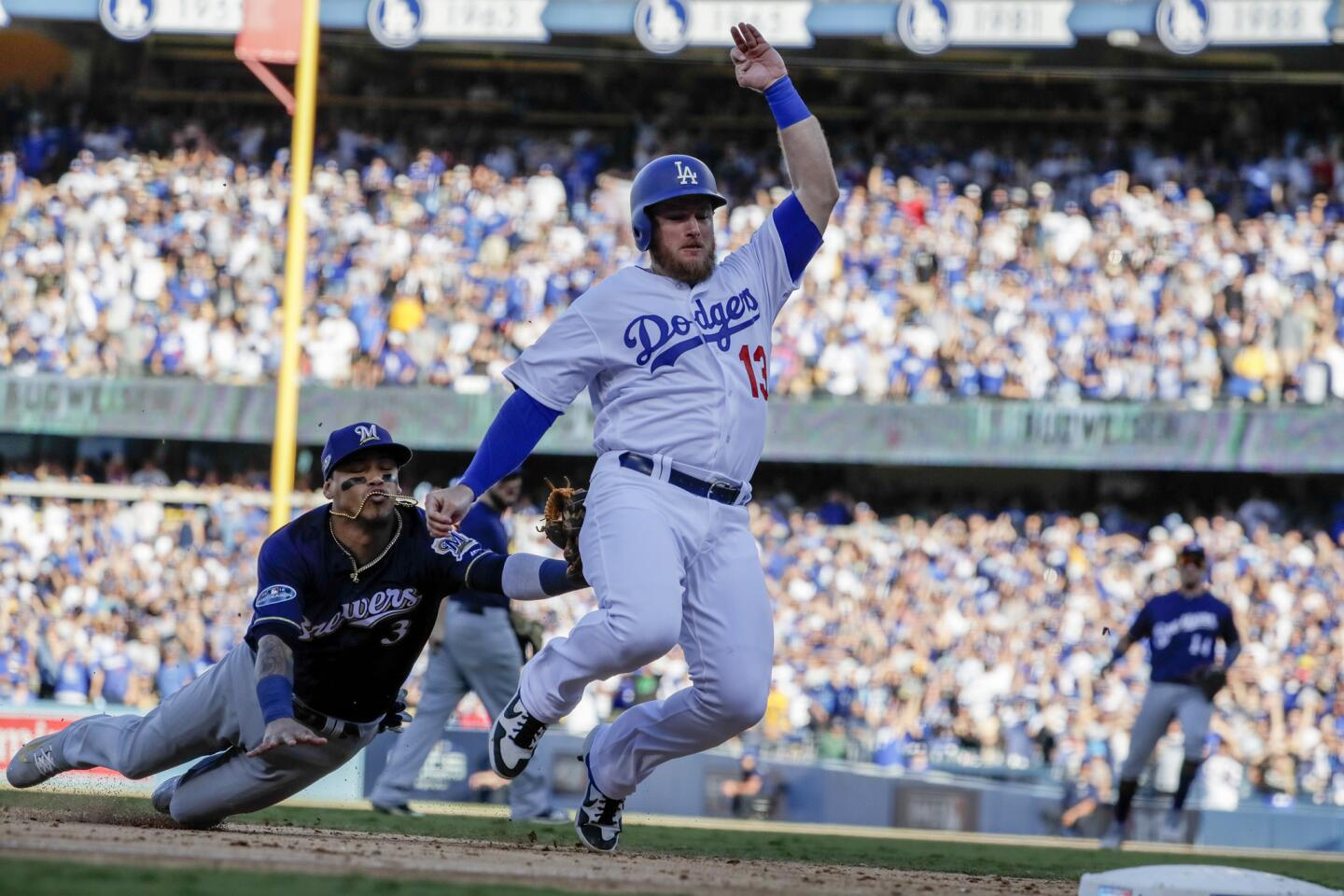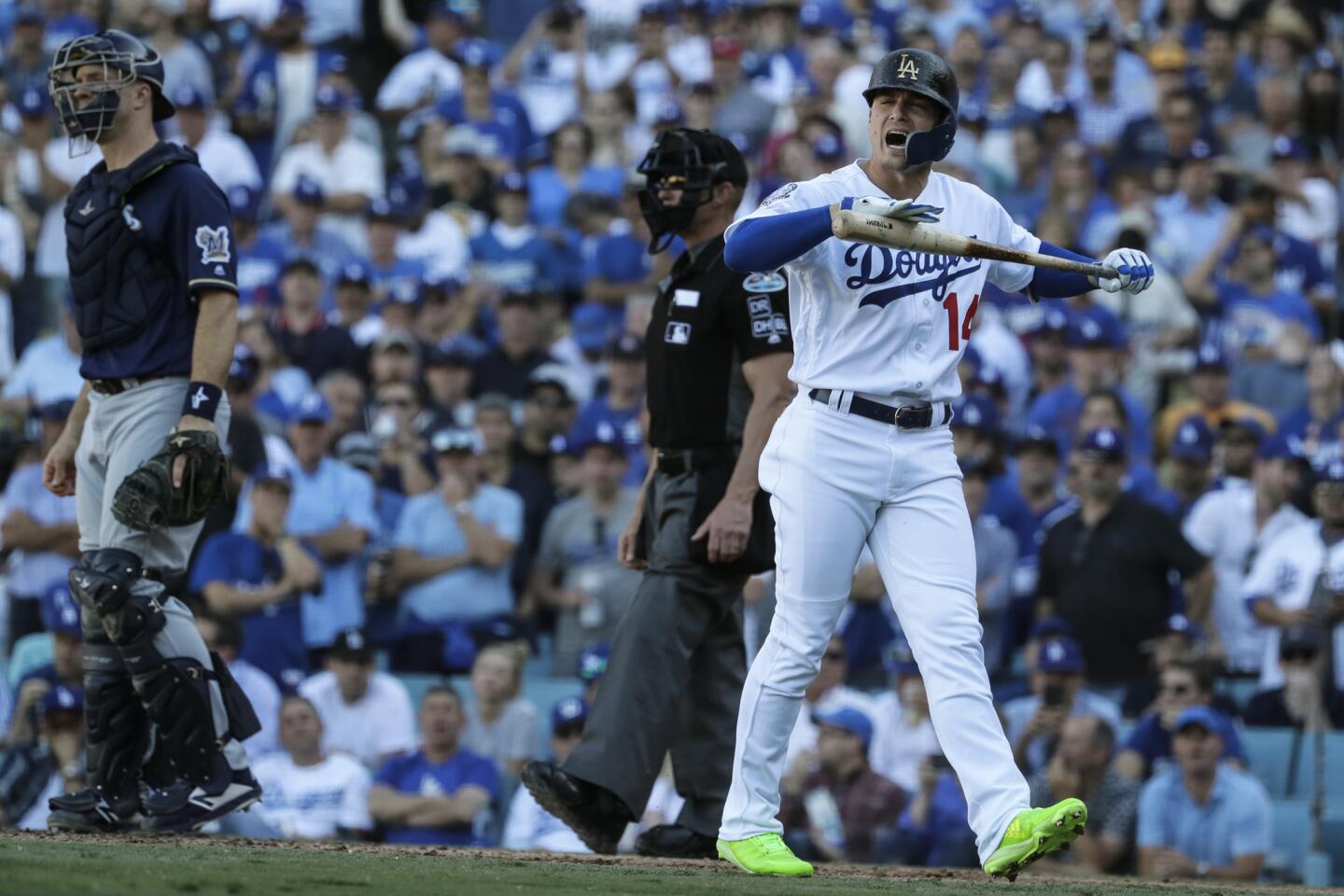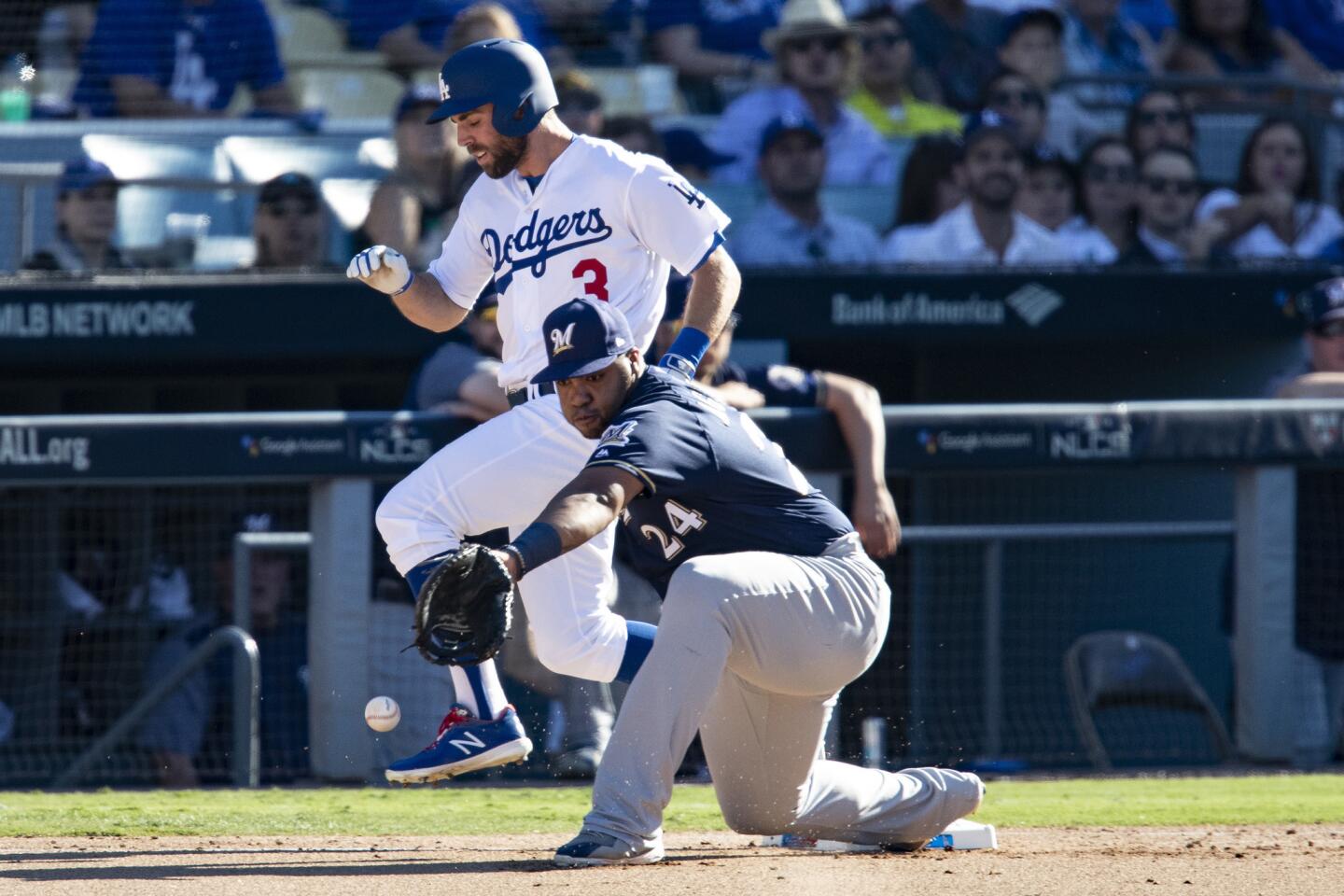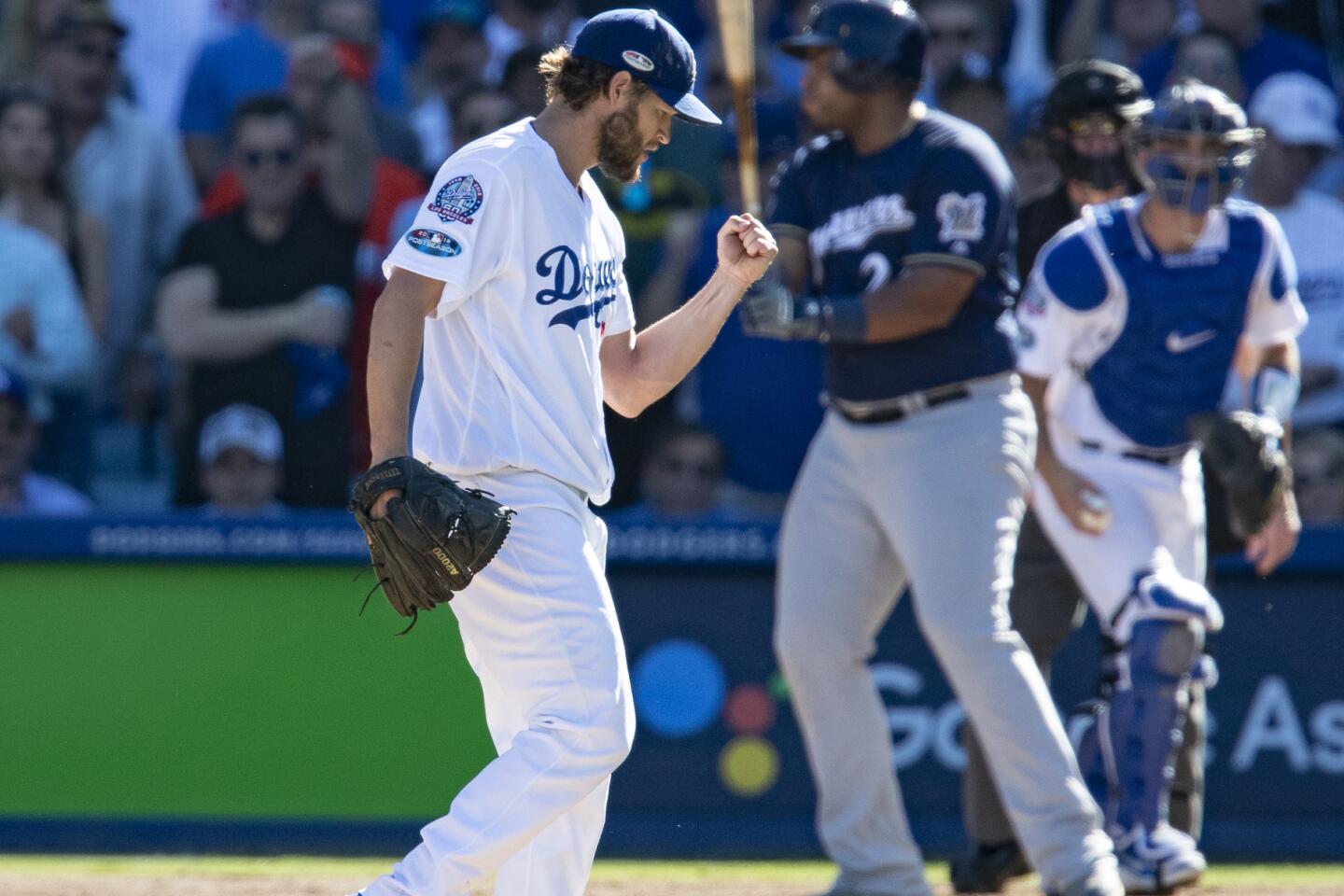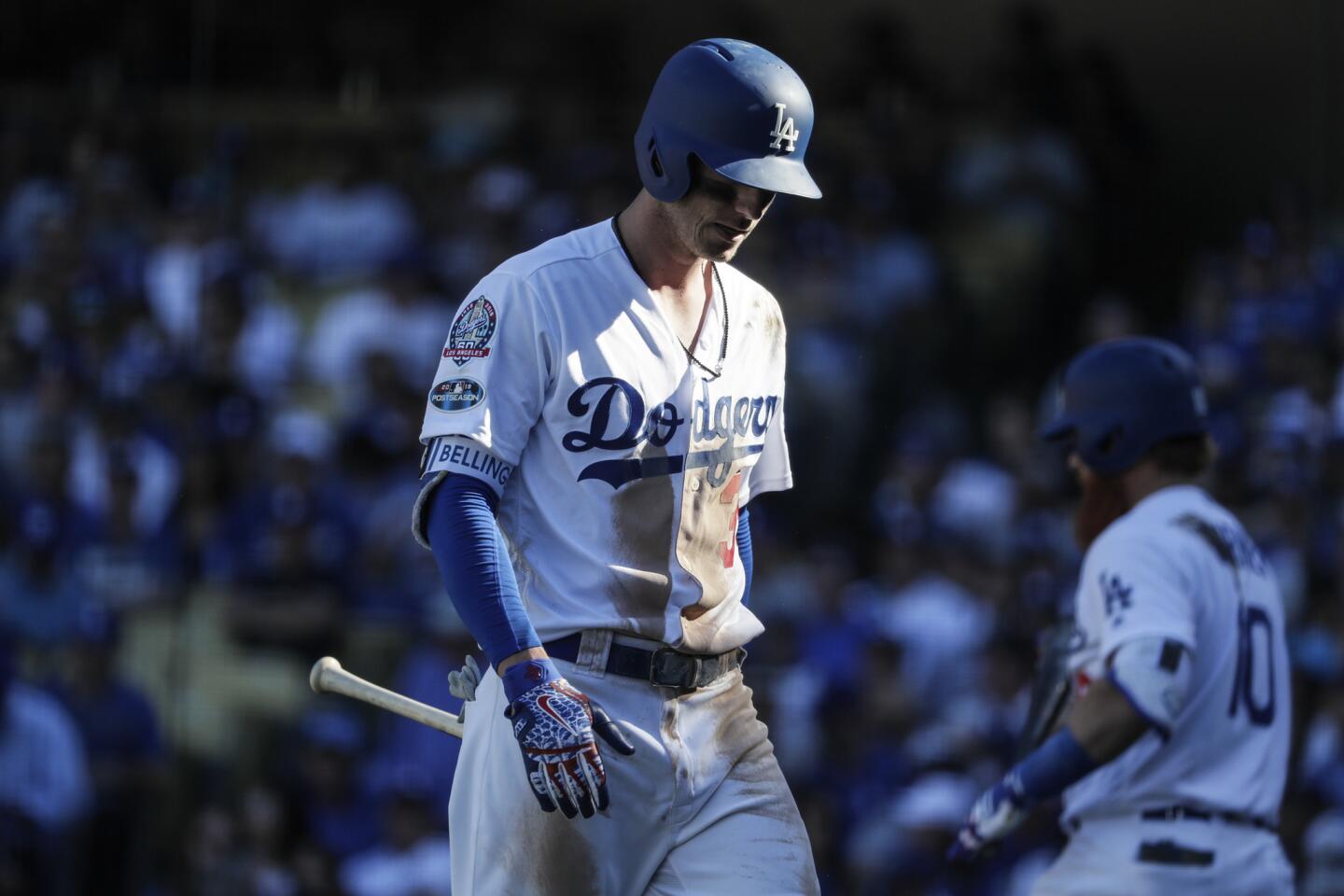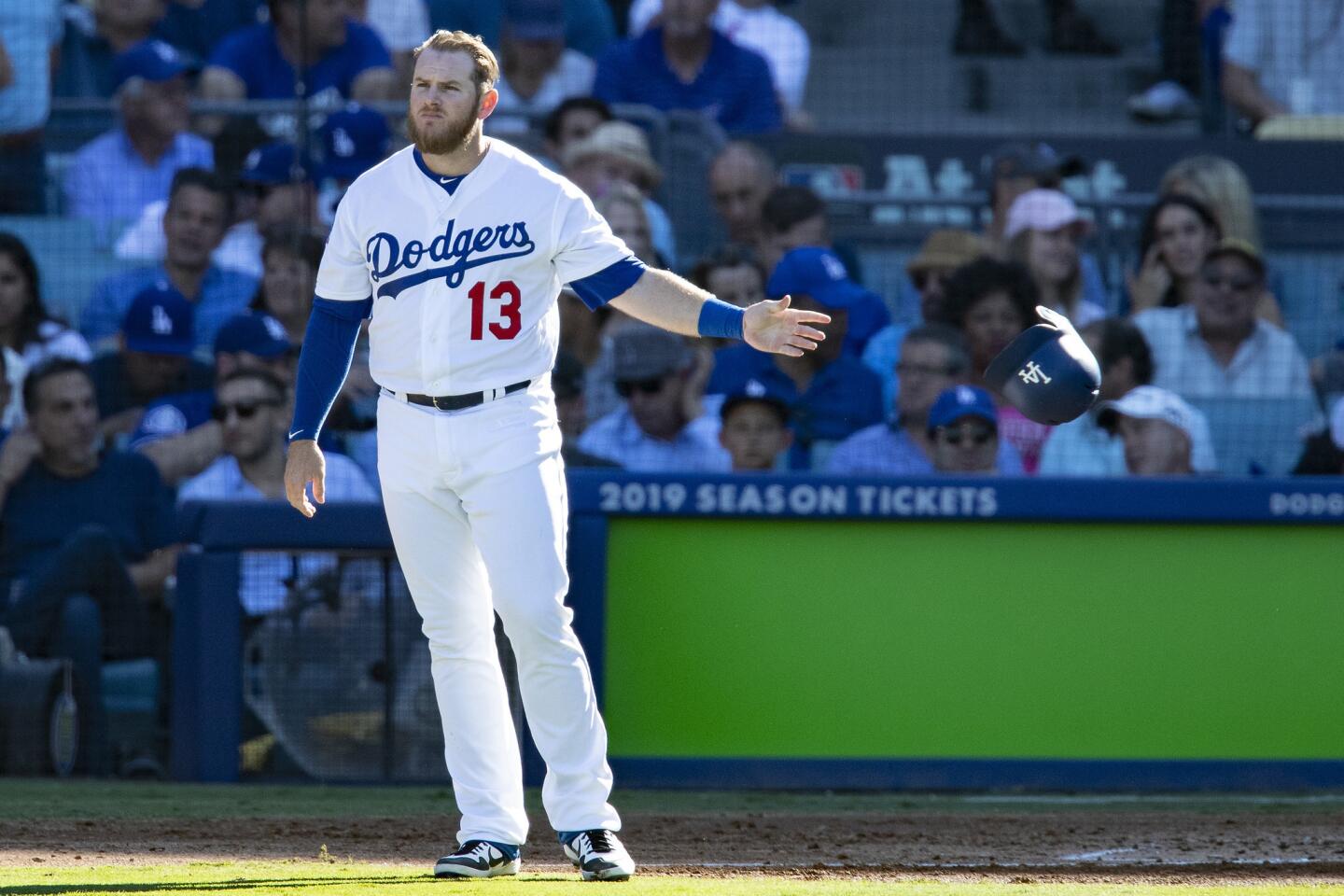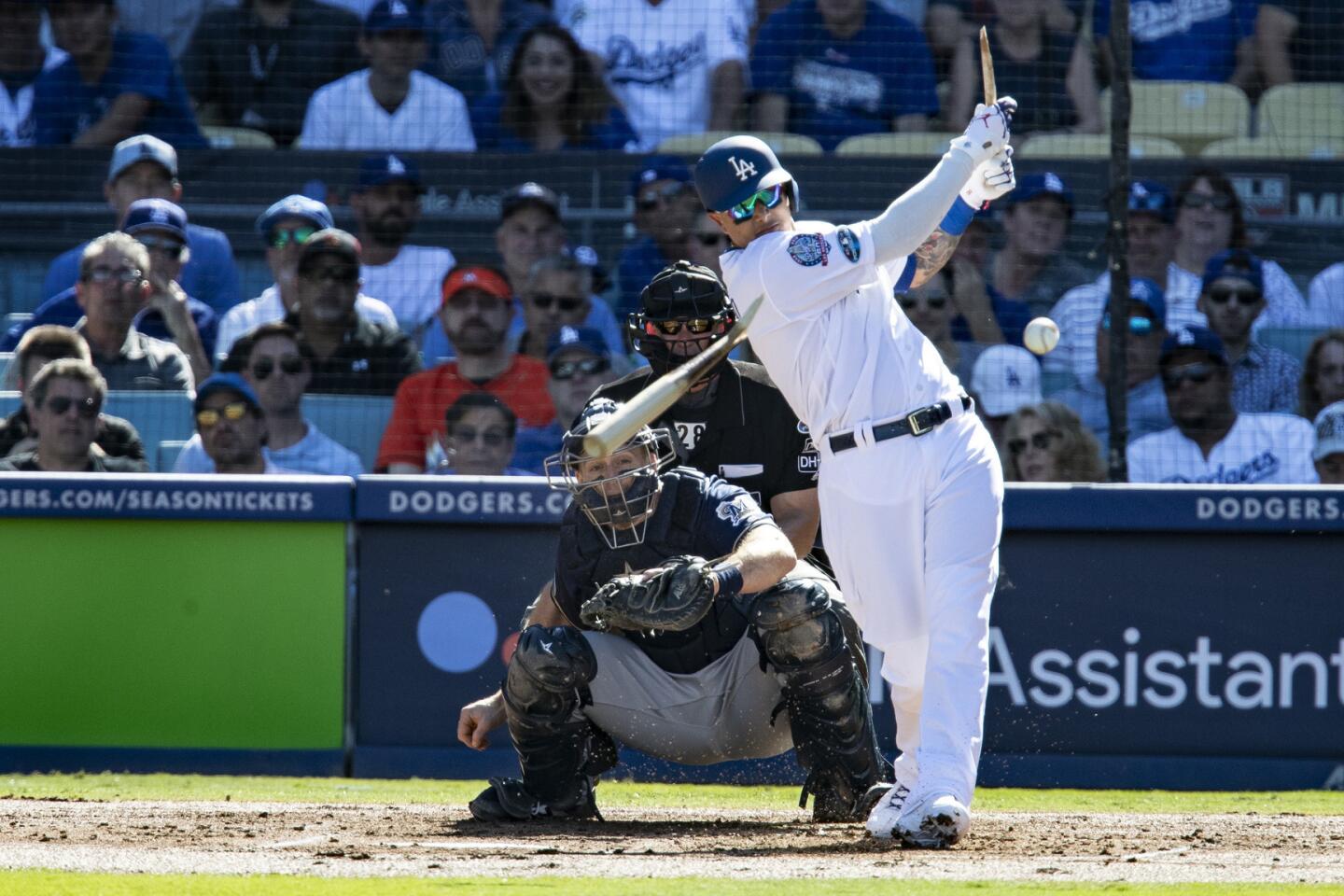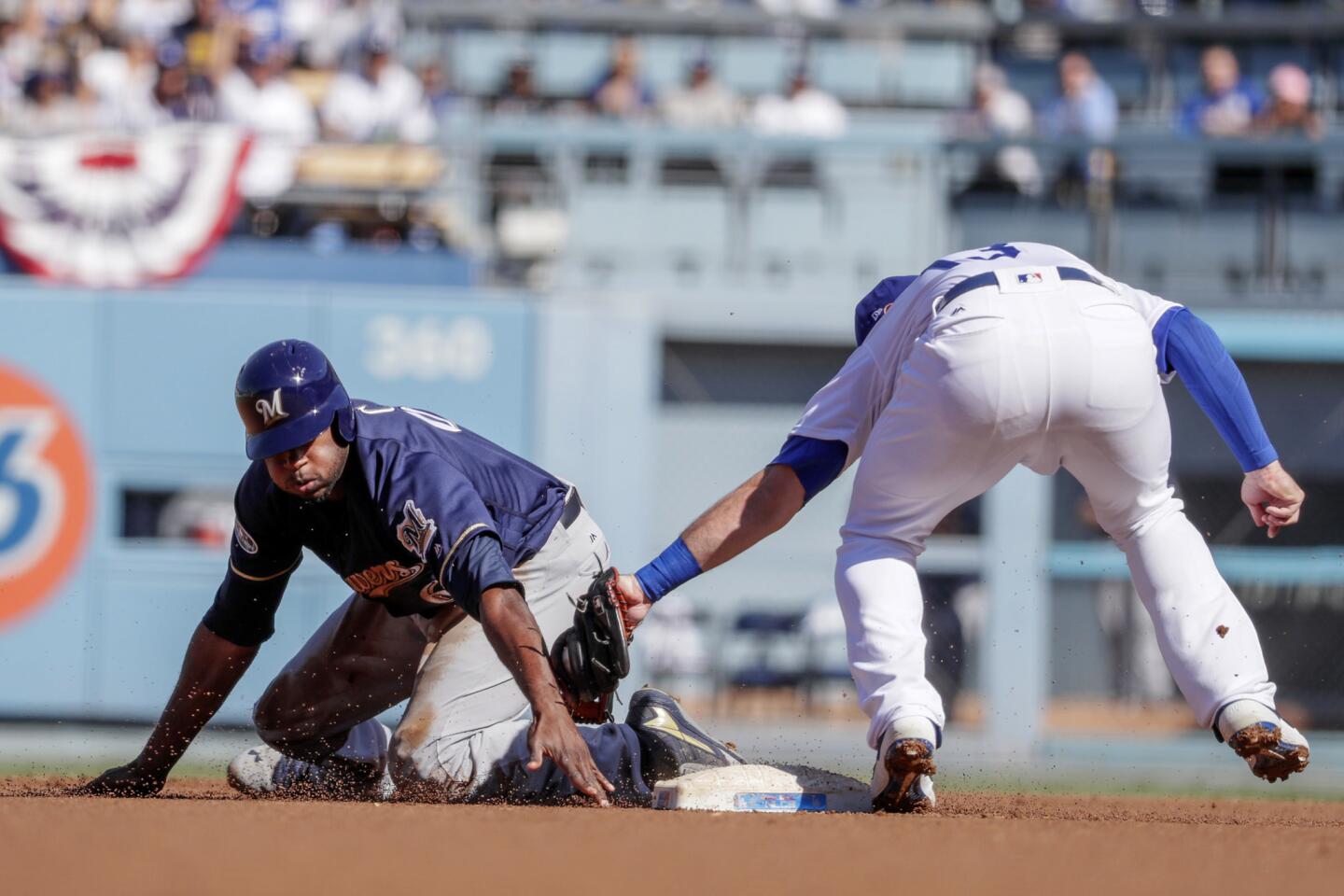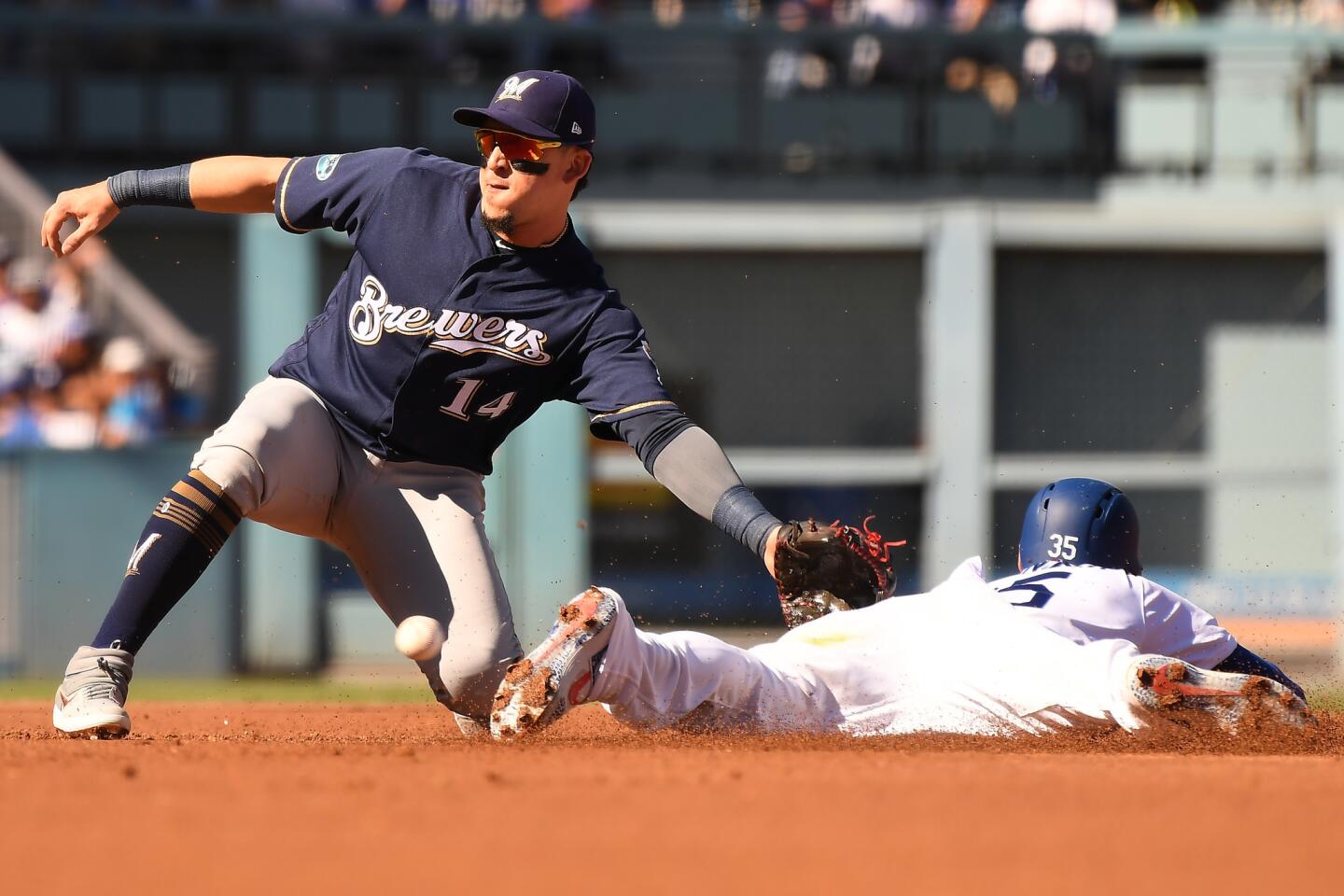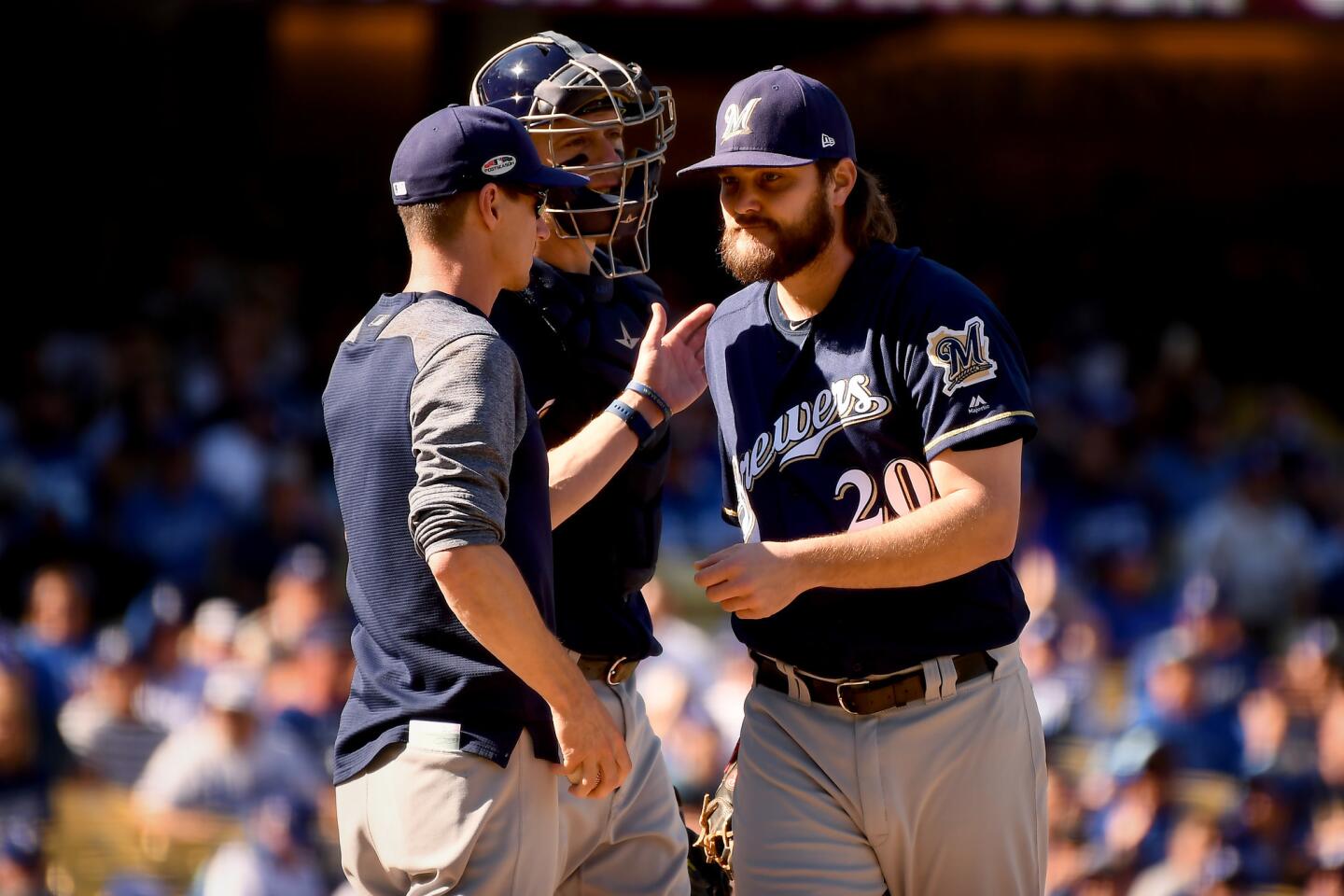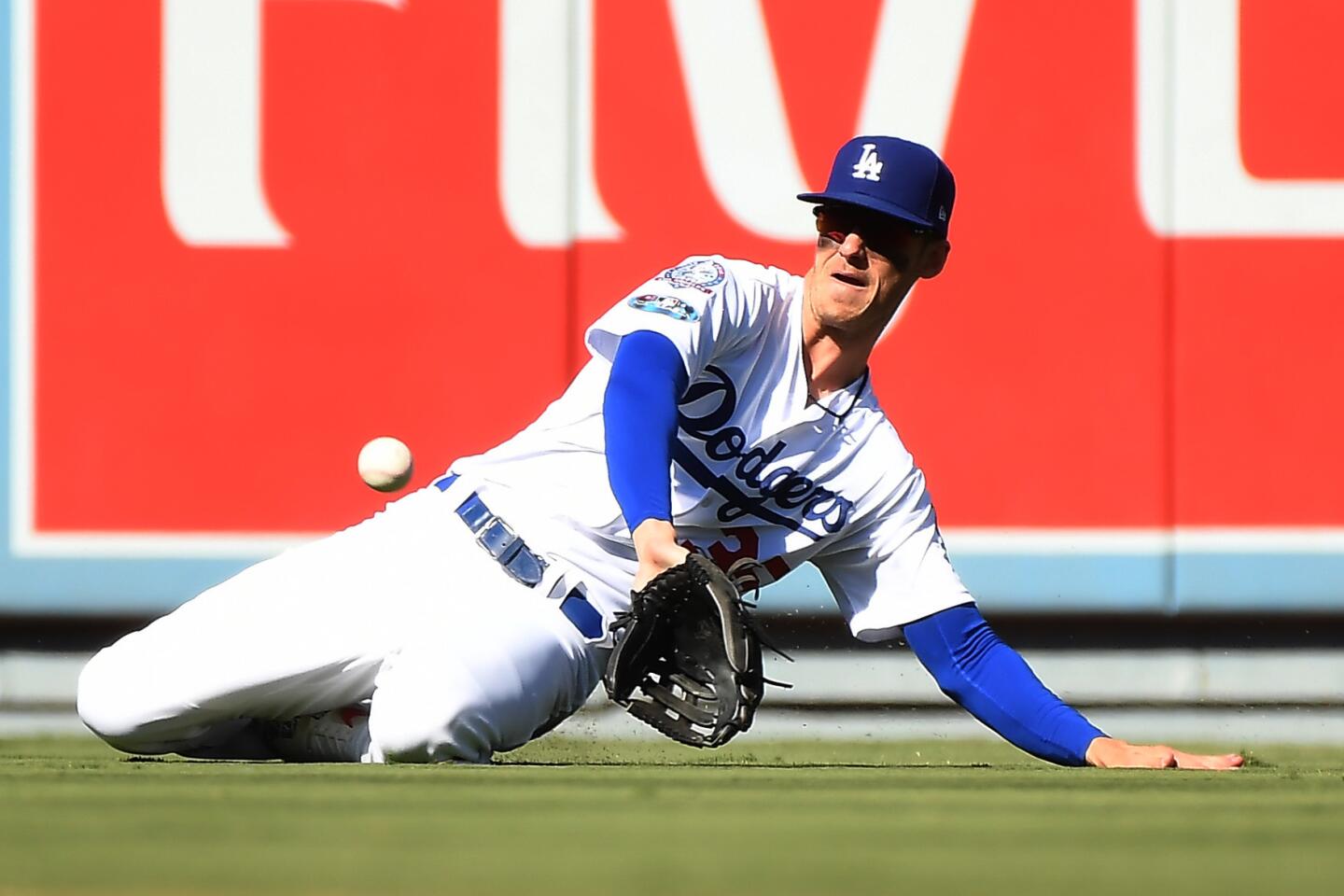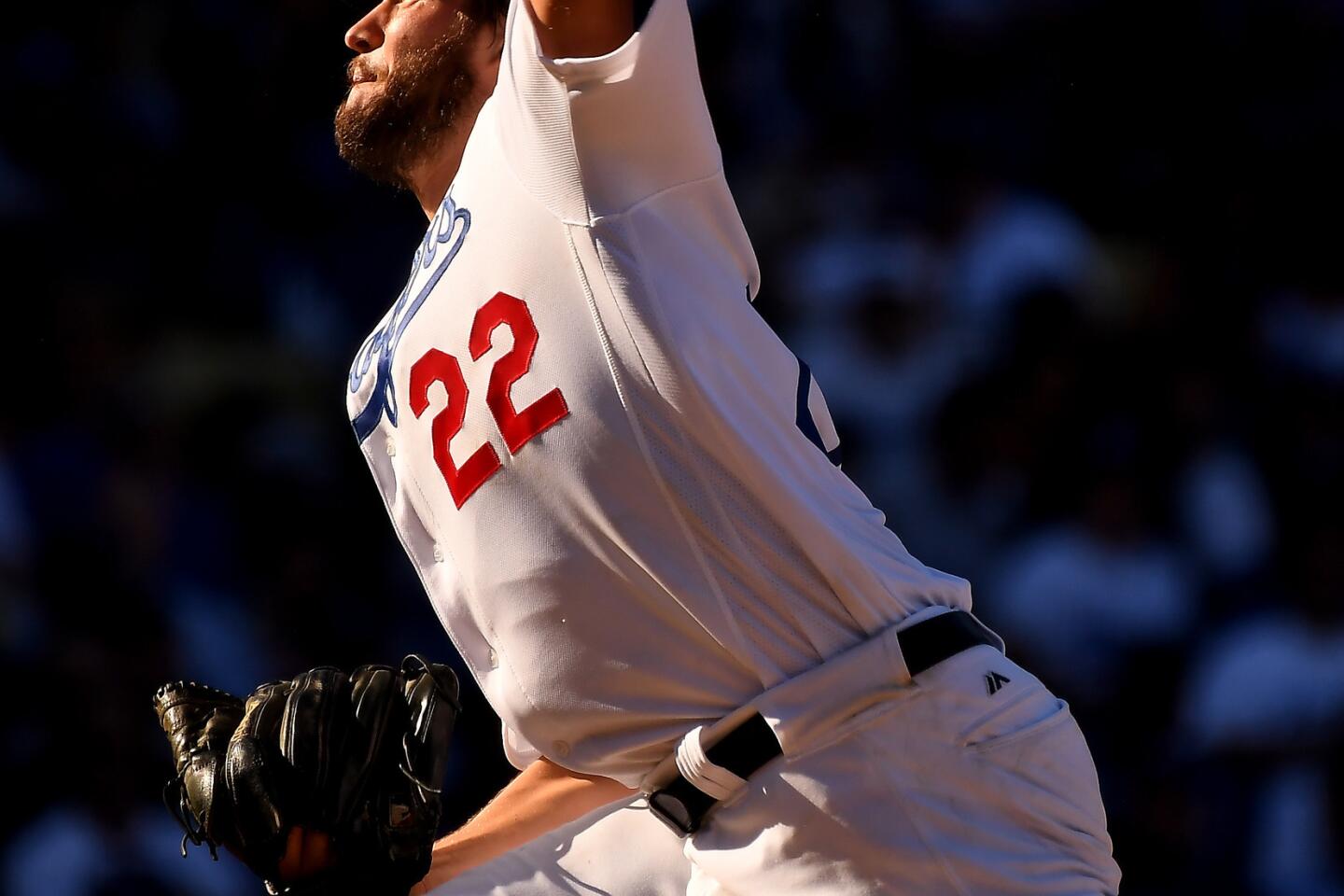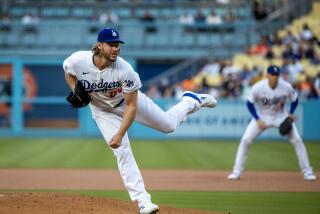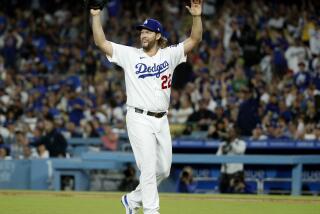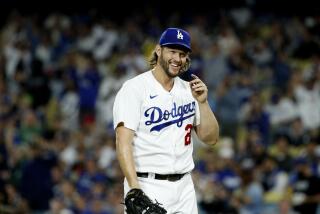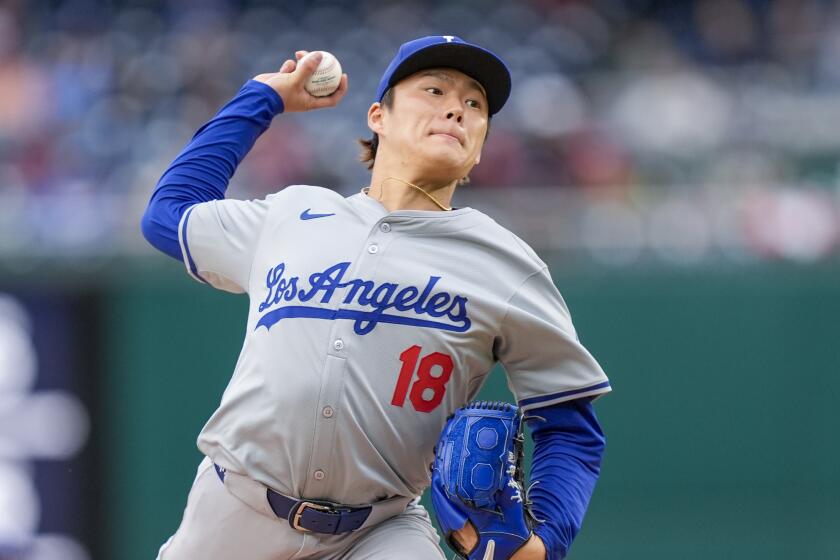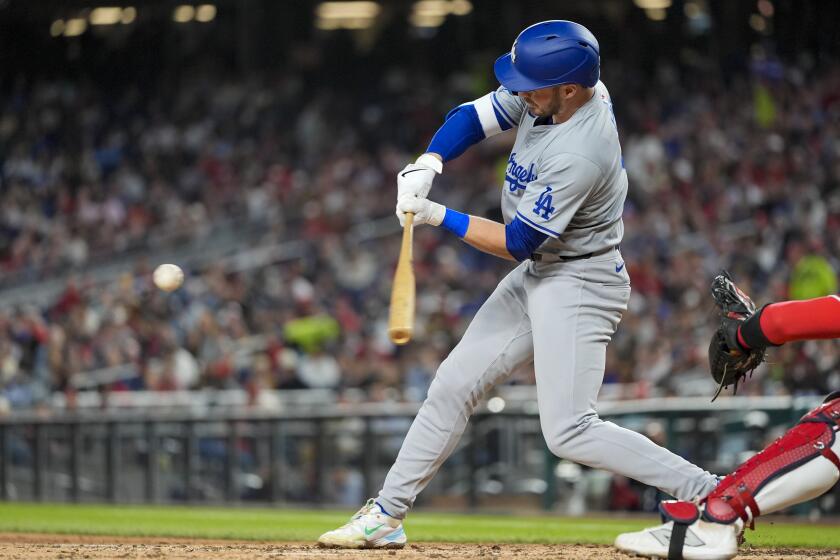Clayton Kershaw delivers a solid performance in the Dodgers’ 5-2 victory over Brewers in Game 5 of NLCS
The opposing starter had departed after facing only one batter, but there Clayton Kershaw stood, on the mound in the center of Dodger Stadium, a living, breathing anachronism for seven innings in an 5-2 victory in Game 5 of the National League Championship Series. The starting pitcher may be going the way of the dodo, but Kershaw is still holding firm, even as his fastball dims and his mileage increases. He is not ready for extinction.
The 2018 season has not been easy on Kershaw. He hurt his shoulder. He hurt his back. Some days hurt his pride. Few games looked worse than the opening night of this series, when the Brewers disposed of him in three-plus innings. Undaunted by the worries about his pitch mix and his psyche, he roared back Wednesday, carving up Milwaukee’s lineup with nine strikeouts to give the Dodgers a 3-2 series lead and deposit the team on the doorstep of another World Series.
“When you get a champion like him, that gets hit around a little bit, he’s going to respond,” manager Dave Roberts said. “And that’s what he did today.”
It is too soon to crown Kershaw. The Dodgers still require five victories to secure the trophy that this city and this franchise have craved since 1988. After a season of discontent, they are on the verge of securing back-to-back pennants for the first time since 1977-1978.
To get there, the Dodgers required a vintage effort from their ace. He learned from his missteps in Game 1, reshaping his approach to silence the Milwaukee offense. On a day when the Brewers attempted to reinvent the wheel, Kershaw ran them over.
Kershaw permitted one run and three hits. He retired the last 13 batters he faced. In the days between his outings, he sharpened his slider and unearthed his curveball. The two pitches complemented each other while protecting his fastball. The Brewers looked flummoxed as Kershaw trusted the curve early in the count, then defensive as he ended at-bats with sliders. To support him, the Dodgers’ offense deviated from their usual strategy of slugging and slumping by making productive outs, slapping singles and running with abandon.
On multiple occasions, Kershaw has joked that if he wins the World Series, he might retire. The chase has lasted a decade now. Along the way, he experienced injury and exhaustion and exultation. Never before has he looked as vulnerable as he has at times this season. Yet here he stands, on the precipice of the oasis.
“It wasn’t as easy maybe as last year to get to this point,” Kershaw said. “But if you would have told us in spring training we would have a chance to go back to the World Series, one game to go, we definitely would have taken that.”
Hyun-Jin Ryu will start Game 6 on Friday at Miller Park, with Walker Buehler holstered for Game 7. Ryu will face the same pitcher listed as the starter Wednesday for Milwaukee. After their bullpen was torched in the 13-inning marathon of Game 4, the Brewers tried some subterfuge.
Before the game, Roberts wondered how long Milwaukee would stick with starter Wade Miley. He also wondered who might start Game 6 on Friday for the Brewers. The answer emerged after one batter: It was Miley.
Penciled in the lineup as the starting pitcher, Miley effectively threw a bullpen session. He walked leadoff hitter Cody Bellinger on five pitches. Brewers manager Craig Counsell emerged from the dugout. Into the game loped Brandon Woodruff, a converted starter capable of logging multiple innings — and a man who had homered off Kershaw in Game 1.
The decision looked confounding on the surface. Why start a pitcher for only one at-bat? The Brewers were attempting to bait the Dodgers into loading up their lineup with right-handed hitters to face the left-handed Miley. Roberts countered by sticking with left-handed hitters like Bellinger and Max Muncy to prevent exploitation. “We were prepared for anything,” Roberts said.
The onus for the afternoon still resided with Kershaw. He aimed to atone for Game 1. The Brewers hounded him that day at Miller Park, spoiling his fastballs and sliders, which resided perilously close in velocity. Kershaw generated zero swinging strikes with his slider, which he threw more than his fastball this season.
As Kershaw regrouped with pitching coach Rick Honeycutt, they decided to increase the usage of his curve, the beautiful bender that first endeared him to the sport. Kershaw chose the pitch only 10 times in Game 1; he spun 21 curves in Game 5.
“You always want a speed separator,” Honeycutt said. “Everybody is talking about how the fastball and the slider are the same speed.” The curveball, he explained, would make the lack of differentiation between the other two pitches less problematic. “A separator of speed puts that doubt in their mind,” he said.
Kershaw flipped two curveballs over the plate in the first at-bat of the game. He put away outfielder Ryan Braun with a pair of whiffs on sliders. Kershaw finished the second inning by fooling third baseman Mike Moustakas with another slider.
He was not impervious. Milwaukee dented Kershaw in the third, with a single by shortstop Orlando Arcia, a walk by Woodruff and an RBI double by outfielder Lorenzo Cain. With the bases loaded, Kershaw punched out first baseman Jesus Aguilar with a 90-mph slider to limit the onslaught. The inning required 32 pitches, but kept the Dodgers close.
“Any time you can work yourself out of situations like that, that’s going to make or break the game,” Kershaw said. “Minimizing damage as best you can as a starting pitcher is huge.”
The Dodgers evened the game in the fifth. Chris Taylor hit an infield single, took second base on a throwing error and stole third base. Austin Barnes tied the game by stroking a single into center.
With Kershaw due up, Yasiel Puig was loosening up in the on-deck circle as Barnes batted. Roberts later admitted this was a ruse. Kershaw was not leaving the game, even if Barnes made an out.
As the shadows began to creep over the diamond, Kershaw gobbled up outs. He kept flashing the curveball, using it as more than a decoy. “Now they have to try to see the ball a little longer, and might get beat with fastballs or get beat with sliders,” third baseman Justin Turner said. “Where before it seemed like they were all over the hard stuff.”
Kershaw struck out two in the fifth. Aguilar waved at a 74-mph curve to finish the sixth. In the bottom of the inning, the offense built Kershaw a lead with RBI singles from Muncy and Puig.
The advantage was safe. Kershaw opened the seventh by fanning infielder Hernan Perez with a curve. He scooped up two more outs on the ground and trotted back to his dugout.
With 98 pitches on his tab, Kershaw would not return to the mound. But Roberts let him hit in the bottom of the seventh. He walked, which set the table for a two-run rally. Bellinger doubled, Turner clapped an RBI single and Brian Dozier drove in a run with a grounder.
A hug from Roberts awaited Kershaw in the dugout. The Dodgers would ask no more from their ace. His day was done, but he was far from endangered.
“It doesn’t matter what happens,” Turner said. “When we know he’s getting the ball, we’re all excited about it.”
Twitter: @McCulloughTimes
More to Read
Are you a true-blue fan?
Get our Dodgers Dugout newsletter for insights, news and much more.
You may occasionally receive promotional content from the Los Angeles Times.
